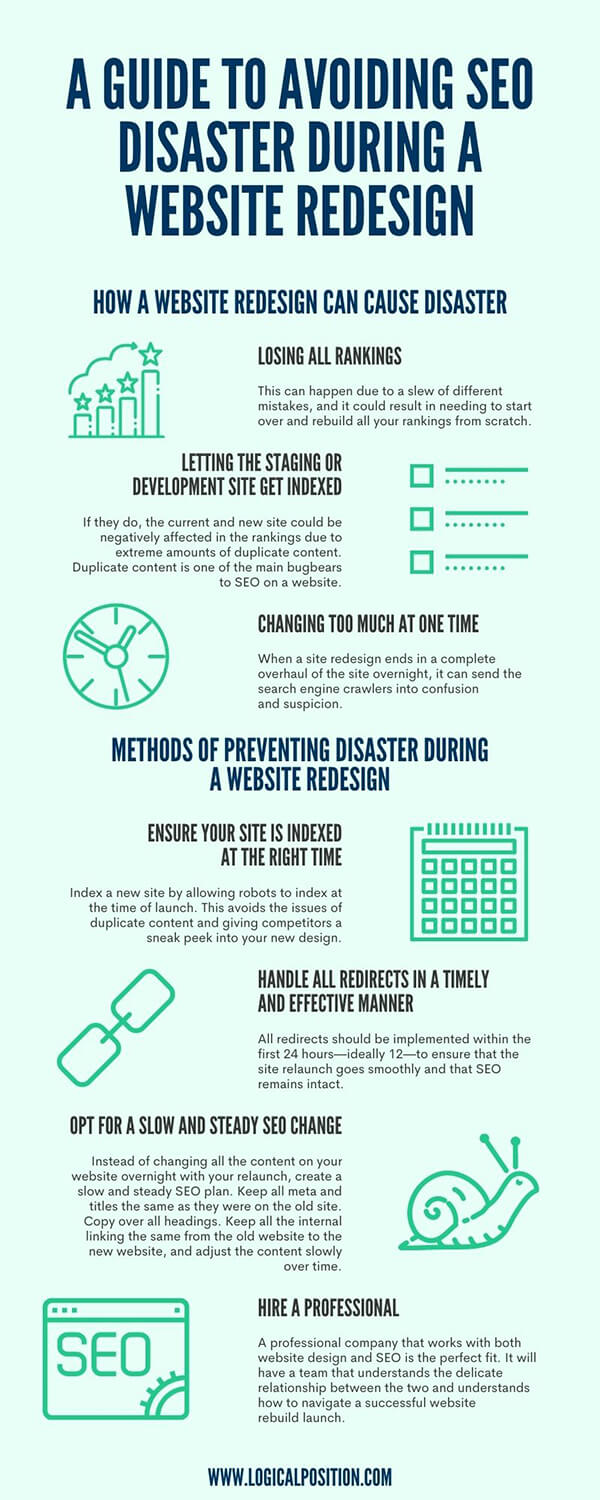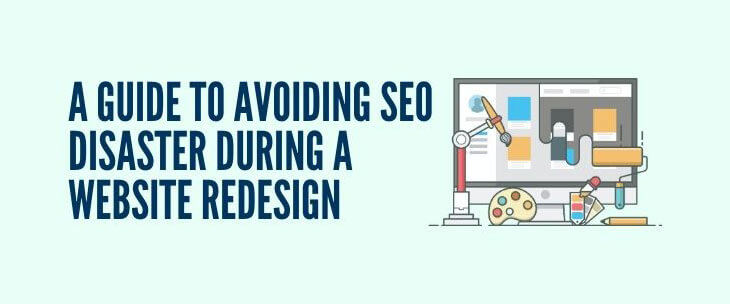When you run a business, it’s vital to maintain a quality website. Whether you run an e-commerce company, a service-based company, or anything in between, your customers expect a quality website for information and access.
A website signifies legitimacy in a world with countless fraudulent businesses. Consumers judge a site within the first few seconds of visiting to determine whether the company is real or a scam. Maintaining trust and customers relies on your site’s design and quality—but potential customers’ ability to find your site relies on its search engine optimization (SEO). Investigate the important relationship between SEO and a website’s quality in this guide to avoiding SEO disaster during a website redesign.
Website Redesign: What Is It and Why Is It Necessary?
A website redesign is also often referred to as a website rebuild or a website migration. The process changes the general look and feel of the site while optimizing it, modernizing it, and reflecting changes within the business. The most common reasons a company may choose to redesign its website include:
- Modernization
- Keeping up with big search engine changes, updates, or mandates
- Keeping up with new Internet marketing trends
- Competing with competitor websites
Many companies to which the Internet is vital to their success rebuild their websites every 24 to 36 months. This keeps their sites fresh, new, and optimized for the ever-changing expectations of consumers and search engines alike.
Modernization
Many companies decide to rebuild or redesign their websites to modernize them. Companies that don’t rely entirely on the Internet for success may do this less often than those that heavily or entirely rely on the Internet. Modernization is mainly design focused. It creates a more standard-looking website for the current times. Just as with any other design type—such as interior design or car design—trends come and go with website design. Failing to keep up with these trends can make a website look outdated, unkept, and untrustworthy.
Search Engine Mandates, Updates, and Changes
Search engines rule the Internet. They decide what people do and don’t see. When search engines such as Google introduce new rules or regulations, websites often need to undergo redesigns to keep up. Not updating your company website after Google introduces a new mandate directly affects your site and can be detrimental to your online traffic.
New Internet Marketing Trends
Keeping up with new Internet marketing trends is crucial to maintaining a solid customer base and an influx of new customers. This applies to both product-based and service-based industries. When new marketing trends emerge, the first companies to adapt to them will typically find the most success with them. Website redesigns allow companies to better implement these new techniques.
Competitor Websites
When a direct competitor introduces a new website design, other businesses tend to follow suit. As an industry evolves and website design changes, it puts pressure on all competing sites to keep up or risk getting left behind.
The Relationship Between SEO and a Website
Search engine optimization and a website’s development and design have a very delicately balanced relationship. They affect each other in a sort of continuous ebb and flow. Explore the unique properties of each and how they’re intertwined.
SEO
Search engines determine what sites relate to key search terms to provide comprehensive and useful results for users when they search for queries or keywords. Search engines employ site crawlers that crawl through every website, indexing and learning what the site stands for, the technical specs of a website, and the purpose of that website.
Search engine optimization is the process of making changes and improvements to a website’s development and content. It helps the search engine crawlers absorb information and get a clear picture of the website. In turn, this leads to the site coming up with higher results for specific key terms.
Website Design, Development, and SEO
Search engines focus on providing their users with a positive and useful experience. By “reading” the text on a site, a search engine site crawler creates a clear picture of what a website looks like and how it will be helpful to a consumer. It also analyzes site speed, user-friendliness, and much more to determine a site’s usefulness.
When a website undergoes a redesign, it Google or other site engines must reindex it. This can create countless issues if SEO changes during the redesign, if site speeds change drastically, or based on numerous other intricate factors.
How a Website Redesign Can Cause Disaster
A website redesign or rebuild can very quickly turn into an SEO disaster. A poorly handled website redesign can lead to catastrophe for businesses. Uncover the common ways web rebuilds can cause SEO disasters:
Losing All Rankings
One of the biggest disasters caused by poor website redesign methods is the site losing all of its previous rankings. This can happen due to a slew of different mistakes, and it could result in needing to start over and rebuild all your rankings from scratch.
Letting the Staging or Development Site Get Indexed
When you’re rebuilding your website, it’s fundamental not to allow Google or other search engine crawlers to index the staging site. If they do, the current and new site could be negatively affected in the rankings due to extreme amounts of duplicate content. Duplicate content is one of the main bugbears to SEO on a website.
Changing Too Much at One Time
When a site redesign ends in a complete overhaul of the site overnight, it can send the search engine crawlers into confusion and suspicion. Making too many changes at one time can negatively affect a site’s SEO.
Methods of Preventing Disaster During a Website Redesign
Executing a successful significant website redesign requires particular expertise and skillful timing. Below are the top methods for preventing an SEO disaster during a website redesign.
Ensure Your Site Is Indexed at the Right Time
To avoid losing all your keyword rankings or getting penalized by Google for duplicate content, ensure your site is indexed at the right time. There’s a small window of opportunity when it’s too early to index the site—which would result in overwhelming amounts of duplicate content—and when it’s not too late to index it. Indexing too late can mean the loss of tons of keyword rankings, resulting in the need to start SEO efforts from scratch or to deal with a long period of nonindexed pages or terms.
Index a new site by allowing robots to index at the time of launch. This avoids the issues of duplicate content and giving competitors a sneak peek into your new design.
Handle All Redirects in a Timely and Effective Manner
After indexing, redirects are the most crucial factors in a site’s successful migration. Here are a few tips and strategies to remember. Creating a checklist like the one below is excellent for ensuring redirects are handled professionally and appropriately.
- Install Google Analytics and Search Console on the new site before launch. Ensure they have the same code as your old website. If you start with new codes, you’ll lose all your historical data and keyword rankings.
- Pull up a site map of the existing live site, go over it, and decide what the migration will look like in terms of remapping URLs.
- Decide on the URL structure. You can keep the URL structure the same, lessening redirects, or change the URL structure to create a more search engine-friendly and user-friendly format.
- Implement all redirects within the first 12 to 24 hours after launching a new site.
- Look at all your site’s backlinks to see if there are any broken ones. If your URLs end in file names or extensions such as “.html,” you could convert them to search engine- and user-friendlier URLs.
Before launching the new site, you should keep a list or spreadsheet of all the URLs that will need redirecting. This keeps things organized so that you know what to do at the time of launch. All redirects should be implemented within the first 24 hours—ideally 12—to ensure that the site relaunch goes smoothly and that SEO remains intact.
Opt for a Slow and Steady SEO change
SEO is a delicate thing. If you change too much content on your site all at once, it can create a sort of suspicion for search engine crawlers, which can lead to dropped rankings. Instead of changing all the content on your website overnight with your relaunch, create a slow and steady SEO plan. Keep all meta and titles the same as they were on the old site. Copy over all headings. You can change these eventually, but changing everything at once impairs SEO efforts. Instead, keep all the internal linking the same from the old website to the new website, and adjust the content slowly over time.
SEO is a continuous effort. Simply creating a new site and changing a few aspects won’t improve your SEO in the long run. Updating content frequently, expertly incorporating keywords, and regularly putting out helpful information is necessary to see real results in search results. However, many companies don’t have the time or resources necessary for positive SEO growth. That’s where agencies such as Logical Position come in. We employ an entire expert SEO team dedicated to developing your organic search result rankings through continuous SEO updates and quality additions on your site.
Invest in Upgraded Hosting
A new site should mean a better site. Running a better website typically requires more resources than running an older one. Always upgrade the hosting when you upgrade your website. This keeps the site speed up to par and avoids slowdowns and interruptions due to inadequate or lower-quality hosting.
Focus on the User Experience
Keep user experience in mind when you’re creating a new website design. SEO is very dependent on user experience, and search engines look for user-friendliness when crawling sites. Too many calls to action, extra clicks, popups, and other things that can frustrate users can increase your bounce rate and lower your rankings on Google. There’s nothing wrong with adding a few new popups or calls to action to your website. However, you should implement these features slowly; otherwise, they could overwhelm users.
For example, if a regular customer goes to your website often, and one day there’s a new chat window, a new e-mail subscription popup, and an entirely new site flow, they may have trouble navigating the new site and leave due to frustration. This will negatively affect your business, and search engines know this and may lower your rankings. People need to ease into new experiences and navigations.
Hire a Professional
Doing a website rebuild the right way the first time is much more efficient and cost-effective than taking a risk and doing it yourself. Should things go south with rankings, retroactively fixing things is much more expensive and detrimental to your company than having a professional handle the redesign in the first place. A professional company that works with both website design and SEO is the perfect fit. It will have a team that understands the delicate relationship between the two and understands how to navigate a successful website rebuild launch.

What To Do If Disaster Strikes
Disaster isn’t uncommon when it comes to a website rebuild. There are many moving parts, and it’s easy for something to go awry. The worst-case scenario is having to start over from scratch with your rankings. This is difficult for any business, especially small businesses—but it is manageable with the right team by your side.
Keep Calm as Rankings Fluctuate
When you complete a website redesign, it’s entirely normal for rankings to experience downward pressure for a short period. There’s always a noticeable dip in rankings when you launch a new website. After the first month or two, the rankings should start to go back up and beyond what they used to be.
Don’t panic when you see these initial ranking drops. If you start trying to fix any issues, you can easily end up perpetuating how long it takes for your site to settle into Google’s index. There will be variances in rankings because the site is new, so the first few months are always a little rocky—but things will eventually even out and improve.
Contact a Professional Right Away
If you notice an extreme drop in rankings or if your rankings don’t recover from initial fluctuation within a month of the site’s relaunch, don’t hesitate to contact a professional. The longer it takes to solve the issue and redevelop keyword rankings, the more negative effects will plague your business. If something seems wrong with your website redesign, if you find challenges with redirects, or if your rankings plummet, contact a professional before making further changes to your site. Going into the site for trial-and-error “fixes” to lowered rankings can further worsen the situation. Consult a professional web development team and expert SEO professionals to develop an action plan to resecure your site’s rankings.
Contact Logical Position for all your website redesign and SEO needs. We have professional teams that work together and understand SEO’s delicate balance with a website during a relaunch period. Contact us for a free consultation on your small business website and to learn more about our SEO offerings. As a Google Partner agency with experts in SEO and website development, we can make your site’s transition seamless.




